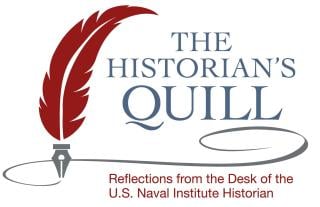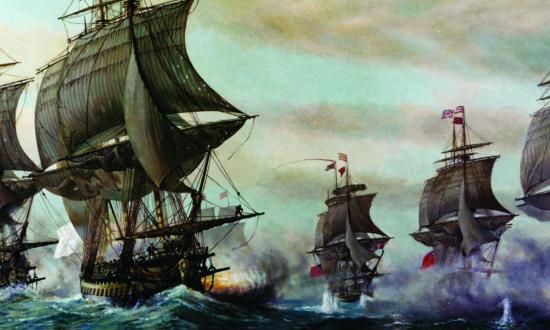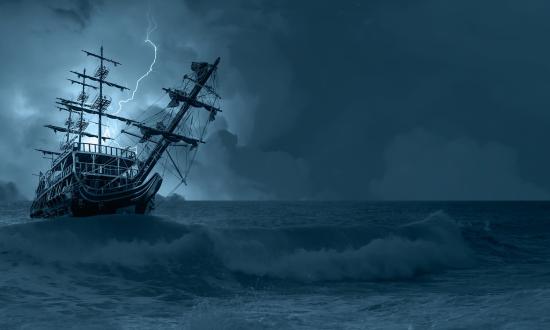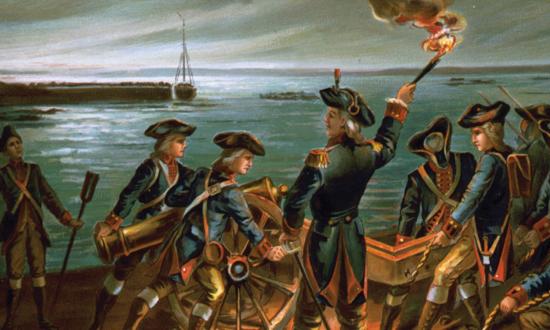Nations can generally be broadly characterized as either maritime or continental in character.
As an example of the difference between continental and maritime powers, consider World War II in Europe. Despite a notable showing in U-boat warfare, Germany’s position in Europe made it more a continental power than a maritime one. Adolph Hitler clearly saw the English Channel as a barrier, unwilling to attempt a military crossing of this relatively narrow band of water that separates the British Isles from continental Europe. Yet, by contrast, the British and the Americans—as maritime nations—saw this same channel as a virtual bridge when the time came to invade Europe, successfully carrying out the so-called D-Day operation in which 5,000 vessels carried over 150,000 men to the shores of Normandy. Indeed, just two years after Hitler had abandoned his halfhearted plans for invading England, the Allies launched an invasion of North Africa—across the Atlantic Ocean.
Hard Choices
From the very beginning, the settlers of the so-called New World had come by sea and continued to rely on that same highway as long as tethers to the old world were needed. The geography of the 13 colonies mandated a continued maritime orientation; besides their substantial coastlines, all had rivers that led to the sea, which often served as barriers to land travel but made intra-colonial communication by water more efficient. Even as the new nation began to expand westward, its governmental and cultural roots were on the eastern seaboard, and this maritime character would continue through the nation’s history with the United States eventually supplanting Great Britain as the world’s preeminent sea power.
Yet, although clearly a maritime nation in terms of its origins, economy, transportation system, and culture, the United States abstained from having a navy for more than a decade after the end of the Revolution. Facing the myriad challenges of building a new nation, the leaders of the new republic were forced to make hard choices as to what the fledgling nation could afford. Because it is an axiom that navies are expensive, there was a general reluctance to keep the Continental Navy in service. Further, there were those who believed a standing military force of any kind posed a danger to the republic itself, and that navies were additionally dangerous because their mobility often leads to unnecessary foreign entanglements.
During the war, the Continental Congress had supported a navy, fitting out a number of existing vessels for combat and optimistically authorizing the building of three 74-gun ships-of-the-line in November 1776. Six years later and the war now over, only one of those ships-of-the-line had been completed, and Congress voted to present the newly completed ship-of-the-line America to France as a gesture of gratitude for French help during the Revolution. Congress further sold off the few remaining ships of the Continental Navy except for the frigate Alliance, which had fought the last battle of the Revolution. She was retained for a time “for the honor of the flag of the United States and the protection of its trade and coasts from the insults of pirates.” But even that eventually proved too much of an expense; on 1 August 1785, the Alliance was auctioned off for $26,000, and the Continental Navy officially sailed into history.
While the arguments against having a navy were compelling to a nation that was very busy creating itself and solving many internal problems, they lost much of their validity in the face of an economy that depended significantly on foreign trade. Yankee mariners roamed the high seas, carrying goods to foreign markets and bringing home needed wares that could only be found in other parts of the world. Without a navy to protect them, these American merchants had to depend on diplomacy, good will, and a stable world situation to carry out their trade unmolested.
Barbary Pirates and the War in Europe
In these early years, because American trade was beneficial to the two European powerhouses—England and France—American merchants could travel the Atlantic in relative safety. But the Mediterranean was another story. Along the coast of North Africa were the so-called Barbary pirates, who had no qualms about seizing merchant vessels for ransom. Technically not pirates because their malevolent activities were sanctioned by their governments—the Sultan of Morocco, the Dey of Algiers, the Bey of Tunis, and the Bashaw (Pasha) of Tripoli—they were nonetheless a serious impediment to trade in the Mediterranean. Most European nations chose to pay extortion money to these despots rather than fight them, believing the latter would be more costly in the long run. Even Britain with its very powerful navy chose this more expeditious route.
The fledgling United States with its struggling economy could not afford this option and, without a navy to protect them, many American merchants simply avoided the Mediterranean, concentrating their trade on the safer Atlantic markets. Those who entered those dangerous waters did so at their own risk, and some paid the high price of becoming slaves to these North African tyrants.
But in 1793, the world situation changed markedly when Britain and France went to war—at first over the upheavals caused by the French Revolution, and later in a life-and-death struggle centered on Napoleon Bonaparte. This conflict would ebb and flow but would continue for the better part of two decades, and the United States ultimately would become involved, fighting first France, then Britain. Initially, the war had a different ramification for Americans. When the Portuguese joined the anti-French coalition, they ended an ongoing conflict with Algiers and withdrew their ships from the Strait of Gibraltar to concentrate on their new Atlantic enemy. This opened the door for Algerian and other Barbary pirates to pour out into the Atlantic where they could attack American merchant ships that had heretofore been safe from such marauding. In just two months, 11 American vessels were seized, eight by the Algerines alone, and more than a hundred Americans were languishing as captives in North African hellish prisons.
After much strident debate, Congress reacted to this new threat by passing the Naval Act of 1794 in March of that year. Once again, America would have a navy—this time it would be known as the United States Navy rather than the Continental Navy. However, because of continuing divisions between naval advocates and the anti-navalists, the Naval Act was a compromise that called for the building of six frigates with the caveat that construction would be halted should an accord be reached with the North Africans.
While negotiations to that effect proceeded, Congress continued its naval preparations by resurrecting the naval rules and regulations written by John Adams in 1775 and by appointing a roster of officers for the new Navy that included six captains: Joshua Barney, John Barry, Richard Dale, Samuel Nicholson, Silas Talbot, and Thomas Truxtun. Design work began on the new frigates by a team headed by Joshua Humphreys, a shipbuilder from Philadelphia, whose designs would prove to be superior to those of conventional frigates of the day. These innovative American versions were larger, more heavily armed, and built of sturdy live oak from Georgia that could take a great deal of punishment, yet they were fast and maneuverable.
While the new frigates would eventually prove to be swift on the waters, they were not so on the building ways—more than two years passed without a single ship completed. In the meantime, a treaty was signed with the Dey of Algiers in September 1795, the terms of which were probably the best a navy-less nation could hope to achieve. In exchange for a cessation of seizures and the release of all the Americans who had been taken, the United States was required to give the Dey a 36-gun frigate and pay a one-time ransom of $642,500, followed by an annual tribute of $21,600 worth of naval stores.
Despite the signing of the treaty—which should have ended work on the frigates in accordance with the congressional compromise—President George Washington, always a strong advocate of sea power, urged their continued construction. Again, a compromise was reached, allowing three of the originally planned six to be completed (the United States, Constellation, and Constitution) with the others (the President, Congress, and Chesapeake) left partially constructed.
The XYZ Affair
As the war in Europe continued, the United States tried to remain neutral, even renouncing the earlier 1778 treaty with France that had enabled vital French help during the American Revolution. It was argued that since the signing of that treaty, the French had experienced a revolution of their own, and a different government was in place, which nullified any previous obligations. The French did not see it that way, and tensions mounted.
Relations with France worsened when John Jay, a special envoy to Britain, negotiated a treaty with the British. While its main purpose was to settle problems left over from the American Revolution, it was perceived in France as detrimental to their interests, and French warships began harassing American merchant shipping in retaliation, seizing 316 U.S. vessels between October 1796 and the following June.
To repair relations with France, President John Adams sent a three-man diplomatic commission to Paris in the fall of 1797, but on their arrival, they were met by three French agents who demanded a substantial bribe as a prerequisite to meeting with the French foreign minister. The American envoys angrily rejected the extorting proposal and returned home. When Adams reported the incident to Congress—referring to the French agents only as “X,” “Y,” and “Z”—war fever swept the country. Referring to the incident as the X-Y-Z Affair, members of Congress coined the expression, “Millions for defense, not one cent for tribute,” and rapidly passed a series of bills that injected new life into the U.S. Navy. Not only was funding approved for the outfitting of the three frigates that had survived the earlier cuts, but also for the three that had been left unfinished. Additional funds were approved for more ships, and patriotic fervor was further demonstrated when citizens in several seaports raised subscriptions for the building and outfitting of additional warships.
The Quasi-War with France
What followed was an undeclared and limited war (fought almost entirely at sea) that came to be known by the odd but descriptive term Quasi-War with France. On 30 April 1798, an act of Congress created the Navy Department, and on 24 May the Ganges—a converted merchant now armed with 26 guns and commanded by Richard Dale—became the first man-of-war of the new Navy to get underway. Other ships soon followed, and by July, the first capture of a French vessel took place when the Delaware—commanded by Stephen Decatur (whose son of the same name would become one of the most famous U.S. naval officers)—captured the French privateer Le Croyable. The French ship was renamed Retaliation and taken into the U.S. Navy for service. Unfortunately, in November she was recaptured by two French frigates.
The new Navy was soon patrolling the Caribbean in four different squadrons. John Barry commanded the largest, but it was former privateersman Thomas Truxtun who would see the most action and emerged as the hero of the Quasi-War.
On 9 February 1799, Commodore Truxtun’s flagship the Constellation was cruising off the coast of Nevis when a lookout reported an unidentified ship just over the horizon. Captain Truxtun ordered his ship to come about, then went below to record in his log: “At noon saw a sail standing to westward, gave chase. I take her for a ship of war.”
The pursuit continued for about an hour with the Constellation—known by many as “the Yankee Racehorse” because of her unusual speed—gradually gaining. As they drew closer, it became apparent that the other ship was a heavily-armed frigate. A lesser captain with a lesser crew might have decided to look for an easier conquest to carry out Congress’ recent edict to “subdue, seize, and take any armed French vessel,” but Truxtun was not lacking in courage, and he knew that the Constellation’s crew was well-trained and ready for a fight.
On his orders, a Marine drummer beat to quarters and all hands took up their stations. Sailors put out the galley fires, removed furniture from the captain’s cabin, opened scuttles to the magazine and shot locker, laid out the surgeon’s dreaded instruments, and sanded down the decks for better traction. Young boys called “powder monkeys” ran back and forth from the gun decks to the powder magazines, the two best quartermasters manned the helm, carpenters made ready their stocks of plugs and oakum for quick hull repairs, and Marines armed with muskets positioned themselves in the rigging and at the rails.
Two hours into the chase, a serious squall arose and within minutes both ships had a common enemy in the gale-force winds. The Constellation fared better, having let go her sheets and braces in time to avoid serious damage, but the French frigate had lost her mainmast to a violent gust.
As the squall subsided, the Constellation continued to close and soon was ranging up on the French ship’s lee quarter. When they were close enough for the American sailors to see the faces of their counterparts peering out from the other ship’s gun ports, they at last heard the long-awaited order, and a great roar echoed across the sea as 24-pounders fired at the French frigate. The heavy balls crashed through the enemy’s side and careened across her deck, inflicting great damage to men and material.
Almost immediately, the enemy answered the Constellation’s broadside with one of her own, and wood splinters flew about like snowflakes in a winter flurry. There was a tearing sound and then a loud crash as a boom fell to the deck, trailing a tangle of lines behind it.
The American gun crews continued servicing their weapons as the confused sea frequently doused them with wind-driven spray, causing clouds of steam to rise from the cannons’ heated barrels. The noise was deafening, the smell of burning powder and running perspiration filled the air, and musket balls and deadly wooden shards—some of them several feet long—flew about, threatening to tear off limbs or snuff out young lives in an instant. At last, with the French ship’s rigging a shambles, her crew decimated and in disorder, her rails shattered, and her hull pierced in many places, her captain struck his flag in surrender. In one of the earliest battles in U.S. Navy history, the Constellation had captured the frigate l’Insurgente, having suffered only three casualties compared to more than 70 on board the French ship. Truxtun had unquestionably set the bar high for the fledgling U.S. Navy. His precedent would not go ignored as men like Decatur, Hull, and Perry would soon follow his example.
On 1 February 1800, Truxtun, still in command of the Constellation, encountered another French frigate, the Vengeance, and after a full day’s chase eventually brought her to battle. In a five-hour engagement that continued after nightfall, the Constellation inflicted such heavy damage on the Vengeance that the French captain tried to surrender several times, but the noise, confusion, and darkness made it impossible for him to communicate. Eventually, the Constellation’s mainmast gave way and toppled into the sea, and when Truxtun broke off the fight long enough to jury-rig a new one, the Vengeance was able to escape into the night. Despite this less than satisfying result, there was no question that Truxtun had handed the French another significant defeat. The Vengeance had suffered more than twice the casualties, and when the French captain later reported the battle, he claimed that he had fought a “superior ship-of-the-line.”
When the Quasi-War essentially ended with the signing of the Convention of 1800 at the end of September, more than 50 French ships had been captured. The schooner Enterprise took 20 French vessels and more than 300 prisoners. The schooner Experiment took the privateers Deux Amis and Diane and recaptured several American merchantmen that had earlier been taken by the French. In a vigorous five-hour fight, the frigate Boston defeated the Le Berceau on 13 October 1800. The only ship lost to the French during the conflict was the recaptured Retaliation. Two other American ships disappeared at sea in August 1800, the revenue cutter Pickering and the frigate Insurgent (then serving in the U.S. Navy after her capture by the Constellation). All told, it was a good beginning for a new navy cobbled together, despite much adversity, to face the world’s second most powerful navy.
Jefferson’s Gunboat Navy
Despite these early successes, there was shoal water ahead for the new U.S. Navy. In the aftermath of the Quasi-War, President Thomas Jefferson—who was among those who feared the potential entanglements that an offensive navy presented—devised a plan that to him seemed a reasonable compromise. He created a relatively cheap gunboat navy that consisted of small, open-decked vessels that were armed with one or two guns mounted on the bow. With only moderate sailing ability and primarily propelled by oars, they had a very limited range and were grouped along the U.S. coast in the major seaports. The advantages, as Jefferson saw it, were that they were entirely defensive and were not only incapable of going overseas but were not likely to provoke an attack by the Royal Navy, which had a history of preemptively striking at fleets that were perceived as a threat.
Jefferson’s gunboat navy proved largely unpopular, and the impracticality of it soon became evident when, in May 1801, the Pasha of Tripoli decided that the amount of tribute being paid by the United States was not enough and declared war. For the next four years, the U.S. Navy carried out a number of offensive operations against Tripoli. While there was no shortage of courage on the Americans’ part, and several of those operations were legendary successes, the Navy was limited in what it could do, and the resulting treaty—reached in June of 1805, primarily because the Pasha had grown tired of the war—left much to be desired. While the Pasha agreed to forego any future payments of tribute, the United States agreed to pay a ransom for the return of its citizens being held captive in Tripoli.
A Strong Nation Needs a Strong Navy
Considering what it had been given to work with, the U.S. Navy had performed surprisingly well in the wars against France and Tripoli, but these early challenges drove home the importance of a strong navy to a maritime nation. The Quasi-war with France ended in a quasi-victory at best, and the Tripolitan War demonstrated what can happen when a maritime nation does not have a powerful navy to protect its citizens and its interests. Naval weakness had lost an American warship and had allowed Americans to languish in a Tripolitan prison, while many others suffered as slaves to Barbary despots.
These were compelling reasons for the United States to embrace a strong navy, but the debate over its naval future continued. The nation would not again make the mistake of trying to do without a navy, but acquiring one suitable for the needs of a maritime nation was still over the horizon, with more challenges ahead. The darkening clouds of war were already gathering as Great Britain began taking advantage of American weakness at sea. In just a few short years, these two maritime nations would again clash on the high seas in a reprise struggle that would pit a fledgling navy against the most powerful navy on earth, further reinforcing the need for a navy capable of ensuring the existence and prosperity of a nation whose very soul was maritime in nature.










